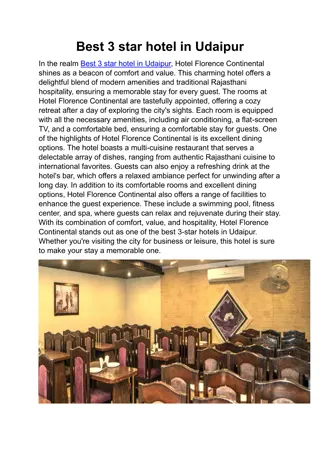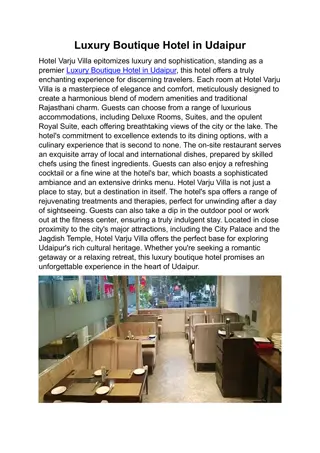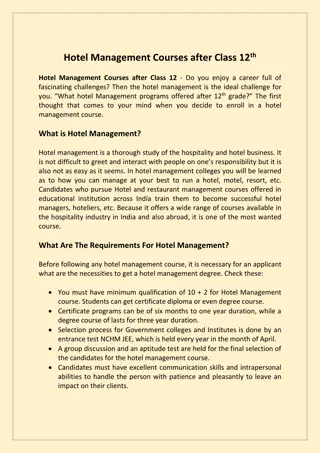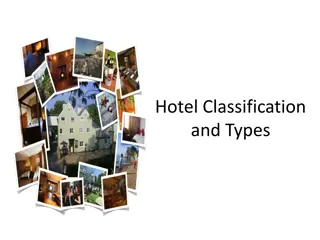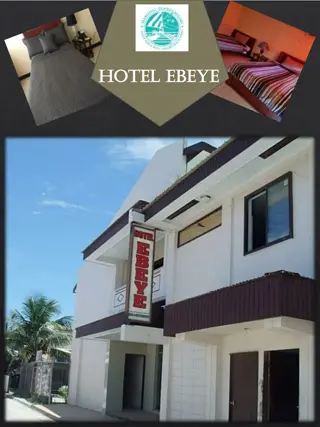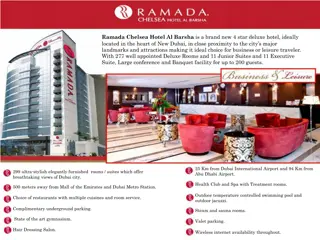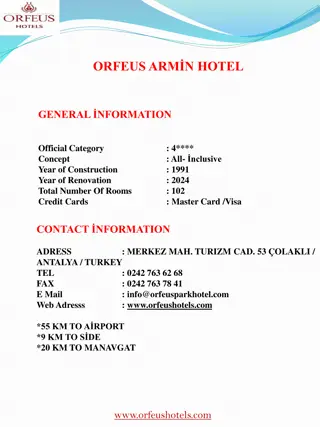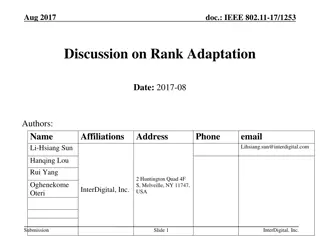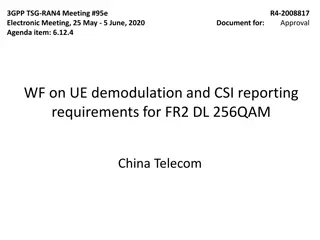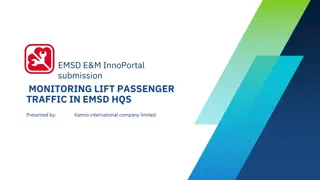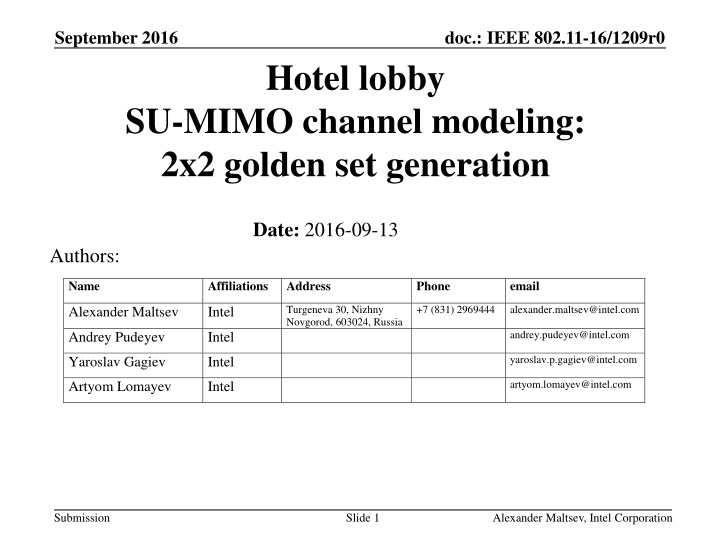
Channel Model Golden Set Generation for IEEE 802.11ay SU-MIMO Systems
This document discusses the generation of a golden set of channel impulse responses (CIRs) for IEEE 802.11ay 2x2 SU-MIMO scenarios. The focus is on the channel representation as a clustered propagation rays set and the generation of ready-to-use CIRs without the need for extensive channel generation procedures. It covers topics such as hybrid beamforming, beamforming selection procedures, and steps involved in generating the golden set. The document provides insights into beamforming configurations, beam selection methods, and the importance of golden set generation for system performance evaluation.
Uploaded on | 4 Views
Download Presentation

Please find below an Image/Link to download the presentation.
The content on the website is provided AS IS for your information and personal use only. It may not be sold, licensed, or shared on other websites without obtaining consent from the author. If you encounter any issues during the download, it is possible that the publisher has removed the file from their server.
You are allowed to download the files provided on this website for personal or commercial use, subject to the condition that they are used lawfully. All files are the property of their respective owners.
The content on the website is provided AS IS for your information and personal use only. It may not be sold, licensed, or shared on other websites without obtaining consent from the author.
E N D
Presentation Transcript
September 2016 doc.: IEEE 802.11-16/1209r0 Hotel lobby SU-MIMO channel modeling: 2x2 golden set generation Date: 2016-09-13 Authors: Name Affiliations Address Phone email +7 (831) 2969444 Turgeneva 30, Nizhny Novgorod, 603024, Russia alexander.maltsev@intel.com Alexander Maltsev Intel andrey.pudeyev@intel.com Andrey Pudeyev Intel yaroslav.p.gagiev@intel.com Yaroslav Gagiev Intel artyom.lomayev@intel.com Artyom Lomayev Intel Submission Slide 1 Alexander Maltsev, Intel Corporation
September 2016 doc.: IEEE 802.11-16/1209r0 Introduction Proposed for 802.11ay channel models, both enhanced 802.11ad legacy and new Q-D models, represent the channel as a set of clustered propagation rays with defined parameters. Based on that, CIRs can be obtained for given TX and RX antenna patterns and beamforming parameters. For LLS and SLS system performance evaluation, it is desirable to have a set of ready-to-use CIRs ( goldenset ), without necessity to do the whole channel generation and beamforming procedures. Present contribution is focused on the channel model golden set generation procedure for base 802.11ay 2x2 SU-MIMO scenarios Submission Slide 2 Intel Corporation
September 2016 doc.: IEEE 802.11-16/1209r0 Hybrid beamforming 2x2 SU-MIMO configuration #1 is considered Two stages beamforming Coarse phased array beamforming: beams selection Fine MIMO processing in the baseband: final adjust Channel after coarse beamforming may be represented as a typical 2x2 MIMO channel Golden set of 2x2 MIMO CIRs is suitable for LLS simulations Submission Slide 3 Intel Corporation
September 2016 doc.: IEEE 802.11-16/1209r0 Golden set generation steps 1. Calculating the channel represented as the set of rays with powers, AoA, AoD and delay parameters Given channel model (802.11ad legacy or 802.11ay Q-D models) is used TX STA is fixed in accordance with considered scenario, RX STAs are uniformly covering the area For given TX-RX positions, select TX and RX beamforming that maximize metric MIMO channel capacity or total throughput may serve as a metric Apply chosen TX and RX beamforming and generate channel impulse responses or the channel transfer matrix for main links (H11, H22) and for cross links (H12, H21) 2. 3. Submission Slide 4 Intel Corporation
September 2016 doc.: IEEE 802.11-16/1209r0 Beamforming selection procedures SISO beamforming selection: Sweeping over N sectors Exhaustive search over TX-RX sectors combinations N2 complexity MIMO beamforming selection: Sector Sweep Search over two TX and two RX sectors N4 complexity Ray-based search for MIMO beamforming selection Search over the existing paths (obtained from ray-tracing), orienting the beams along M rays: M2 complexity for SISO and MIMO Ray-based search were selected for 2x2 MIMO channel beamforming Submission Slide 5 Intel Corporation
September 2016 doc.: IEEE 802.11-16/1209r0 Channel selection metric To select best channel H (defined by selected TX and RX beamforming) the simple per-subcarrier capacity metric was used: ? = ???2 1 + ????1 + ???2 1 + ????2 ?11 ?212+ ?0,????2= 2 2 ?22 ????1= ?122+ ?0 Capacity is calculated under assumption of simple spatial separation of the streams, without RX MIMO processing. To obtain single value to maximize, per-subcarrier capacity is averaged over the all band The more complex metrics, with RX MIMO processing, such as OL-MIMO MMSE capacity (and throughput) were tested and produced almost the same results in term of beamforming Submission Slide 6 Intel Corporation
September 2016 doc.: IEEE 802.11-16/1209r0 Hotel lobby scenario Deployment: Room size is 20x15x6 m (X-Y-Z) STA placed every 0.5 m with 1m shift from the nearest all, AP place at 0.5m from the wall. Scenario and model: Large hotel lobby, Q-D model ([1], section 5.3) D-rays: up to second order + 5 R-rays Intra cluster structure Parameter AP height, Htx AP position STA height, Hrx Room height Room width Room length Floor material Floor rf Value 5.5 m Center, 0.5m from the wall 1.5m 6 m 15 m 20 m Concrete 4 + 0.2j 0.1 mm Concrete 4 + 0.2j 0.2 mm Plasterboard 6.25+0.3j 0.2 mm Floor roughness standard deviation f Walls material Walls rw Walls roughness standard deviation w Ceiling material Ceiling rc Ceiling roughness standard deviation c [1] doc.: IEEE 802.11-15/1150r4 Channel Models for IEEE 802.11ay Submission Slide 7 Intel Corporation
September 2016 doc.: IEEE 802.11-16/1209r0 Hotel lobby golden set: SU-MIMO mode SU-MIMO configuration #1 ([1],section 3.2.1) Co-polarized antennas (vertical polarization) Each element has single polarization Device #1 Device #2 V pol H pol Beam #1 or E E Beam #2 H or V pol H or V pol Device #1 Device #2 Beam #1 Phase shifter Beam #2 Signal 1st stream PAA element H or V pol H or V pol Signal 2nd stream [1] doc.: IEEE 802.11-15/1150r4 Channel Models for IEEE 802.11ay Submission Slide 8 Intel Corporation
September 2016 doc.: IEEE 802.11-16/1209r0 Hotel lobby golden set: antennas setup TX and RX antenna arrays Gaussian antenna pattern (equivalent to 2x8 antenna array). Gain 15 dBi, front-to-back ration: 15 dB, 10 dBm power Beamwidth [15 , 60 ] Vertical polarizations Ideal beamsteering Antenna broadside is rotated in the desired direction For more realistic / implementation dependent results, antenna arrays with realistic beamsteering and random orientations can be used Submission Slide 9 Intel Corporation
September 2016 doc.: IEEE 802.11-16/1209r0 2x2 MIMO channel analysis To illustrate the properties of generated 2x2 MIMO channel, the distributions of different basic metrics over all STAs were calculated Distribution of SINRs per subcarrier for both streams Distribution of total capacity in both streams Distribution of throughput estimates, assuming SC transmission To comply with the sum capacity metric, the Horizontal MIMO were modeled: different MCSs for different streams NLOS were modeled by blocking rays within 20 angle around LOS Submission Slide 10 Intel Corporation
September 2016 doc.: IEEE 802.11-16/1209r0 2x2 MIMO channel analysis: 2D distributions LOS channel NLOS channel SISO MIMO (2x TX power) Submission Slide 11 Intel Corporation
September 2016 doc.: IEEE 802.11-16/1209r0 Summary A methodology for generation of 2x2 SU-MIMO channel realizations golden set for LLS and SLS simulations was proposed The reduced complexity beam selection procedure for 2x2 MIMO channel generation was investigated The CIRs golden set for Hotel lobby scenario 2x2 MIMO was generated and analyzed for LOS and NLOS cases SLS simulations have shown that generated CIRs have a good spatial separation and 2x2 MIMO scheme outperforms SISO scheme for considered cases Submission Slide 12 Intel Corporation



